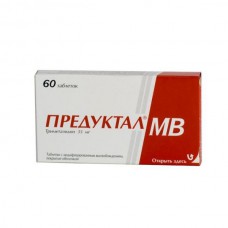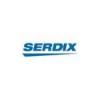Expiration date: 06/2026
The composition and form of issue:
Tablets with modified release, film-coated. 1 tablet contains:
of Trimetazidine dihydrochloride 35 mg
excipients: calcium hydrogen phosphate dihydrate povidone magnesium stearate titanium dioxide (E171) iron oxide red (E172) glycerol silicon dioxide colloidal anhydrous, macrogol, hypromellose
in a contour acheikova packing 20 or 30 PCs in a pack 2 packs cardboard.
Description pharmaceutical form:
Round, biconvex tablets, film-coated pink. Color tablets on a break — white.
Pharmacokinetics:
After oral Trimetazidine is rapidly absorbed and reaches Cmax in plasma after approximately 5 h. Over 24 h the concentration in the blood plasma remains at a level higher than 75% concentration, as defined in 11 h. the Equilibrium state is achieved after 60 h food Intake did not affect the bioavailability of Trimetazidine.
Vd is 4.8 l/kg, which indicates a good distribution of Trimetazidine in the tissues (the degree of bonding with blood plasma proteins is quite low, about 16% in vitro).
Trimetazidine is excreted mainly by the kidneys, mainly unchanged. T1/2 in young healthy volunteers to about 7 h, in patients over 65 years — about 12 hours
The renal clearance of Trimetazidine is directly correlated with creatinine Cl, and hepatic clearance decreases with age of the patient.
It is shown that at elderly patients when taking a daily dose of 2 table. of Trimetazidine in 2 hours exposure increase in blood plasma does not increase the severity of any effects compared with placebo.
Description pharmacological action:
Trimetazidine prevents a decrease in intracellular ATP concentration by maintaining energy metabolism of the cells in condition of hypoxia. Thus, the drug ensures the normal functioning of membrane ion channels, transmembrane transport of ions of potassium and sodium, and maintaining cellular homeostasis.
Trimetazidine inhibits fatty acid oxidation through selective inhibition of the enzyme 3-ketoacyl-COA thiolase (3-KAT) tryapochkoy mitochondrial isoforms of fatty acids, which leads to increased oxidation of glucose, including due to the acceleration of glycolysis, which results in protection of the myocardium from ischemia. Switching energy metabolism from fatty acid oxidation to glucose oxidation is the basis of the pharmacological properties of Trimetazidine.
It was experimentally confirmed that Trimetazidine has the following properties:
- supports energy metabolism of the heart and neurosensory tissue during ischemia
- reduces the severity of intracellular acidosis and changes in transmembrane ion flow that occurs during ischemia
- lowers the level of migration and infiltration polinuklearna of neutrophils in the ischemic and reperfusion the tissues of the heart
- reduces the size of myocardial damage
- has no direct impact on hemodynamic parameters.
In patients with angina pectoris, Trimetazidine:
- increases coronary reserve, thereby slowing the onset of ischemia, caused by physical activity, starting with 15-th day of therapy
- limits the fluctuations of HELL caused by physical strain without significant changes in heart rate
- significantly reduces frequency of angina attacks and need for nitroglycerin short-acting
- improves contractile function of the left ventricle in patients with ischemic dysfunction.
In the clinical trial duration of 2 months, it was shown that the addition of tablets of Trimetazidine modified-release at a dose of 35 mg to therapy with atenolol in a dose of 50 mg every 12 h after ingestion led to a significant slowing of the onset of the ischemic depression of ST segment during the load tests.
Indications:
cardiology: prolonged therapy of ischemic heart disease, prevention of attacks of stable angina in the composition of mono - or combination therapy
ENT diseases: treatment vestibulocochlear disorders ischemic nature, such as dizziness, tinnitus, impaired hearing
ophthalmology: chorioretinal disorders with ischemic component.
Contraindications:
hypersensitivity to any component of the drug
patients with severe renal insufficiency (creatinine Cl <15 ml/min)
patients under 18 (due to the lack of sufficient clinical data the drug is not recommended).
Caution: patients with severe hepatic failure (limited clinical data).
Application of pregnancy and breast-feeding:
Animal studies revealed no teratogenic effect, however, due to the lack of clinical data to use the drug Preductal MR during pregnancy is not recommended.
It is unknown whether Trimetazidine penetrates in breast milk. If necessary, use of the drug Preductal MR lactation breastfeeding should be discontinued.
Side effects:
The frequency of side effects noted when taking of Trimetazidine in the following gradation: very often (>1/10), often (>1/100, <1/10) uncommon (>1/1000, <1/100) rare (>1/10000, <1/1000) very rare (<1/10000), including individual messages.
From the digestive system: often — pain in the abdomen, diarrhea, dyspepsia, nausea, vomiting.
General disorders: common — asthenia.
CNS: frequently — dizziness, headache, rarely — extrapyramidal symptoms (tremor, rigidity, akinesia), reversible after drug withdrawal
With the skin: often — skin rash, itching, hives.
From the CCC: rarely — orthostatic hypotension, tides blood to the skin.
Drug interactions:
It was not observed.
Method of application and dose:
Inside, alone with liquid, squeezed water, and 1 table. 2 times a day, morning and evening, during meals.
The duration of treatment determined by the doctor.
Overdose:
There is only very limited information on overdose of Trimetazidine. In case of overdose should be symptomatic therapy.
Special instructions:
Preductal MR is not intended for relief of angina attacks and is not indicated for initial therapy of unstable angina or myocardial infarction, as well as in preparation for hospitalization or in the first days.
In the case of angina should be reviewed and tailor the treatment (medical therapy or revascularization holding).
Effects on ability to drive and perform work requiring high speed of psychomotor reactions
Preductal MR little effect on the ability to drive vehicles and perform work requiring high speed physical and mental reactions.
In connection with the possible development of dizziness and other side effects should be careful when driving and occupation of other potentially hazardous activities, require high concentration and psychomotor speed reactions.


